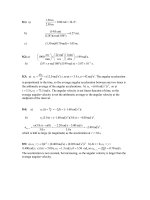Tài liệu Javascript bible_ Chapter 32 pptx
Bạn đang xem bản rút gọn của tài liệu. Xem và tải ngay bản đầy đủ của tài liệu tại đây (105.98 KB, 20 trang )
JavaScript
Operators
J
avaScript is rich in operators: words and symbols in
expressions that perform operations on one or two values
to arrive at another value. Any value on which an operator
performs some action is called an operand. An expression
may contain one operand and one operator (called a unary
operator) or two operands separated by one operator (called
a binary operator). Many of the same symbols are used in a
variety of operators. The combination and order of those
symbols are what distinguish their powers.
Operator Categories
To help you grasp the range of JavaScript operators, I’ve
grouped them into five categories. I have assigned a wholly
untraditional name to the second group — but a name that I
believe better identifies its purpose in the language. Table 32-1
shows the operator types.
Table 32-1
JavaScript Operator Categories
Type What It Does
Comparison Compares the values of two operands, deriving a
result of either true or false (used extensively in
condition statements for
if...else
and
for
loop constructions)
Connubial Joins together two operands to produce a single
value that is a result of an arithmetical or other
operation on the two
Assignment Stuffs the value of the expression of the right-hand
operand into a variable name on the left-hand side,
sometimes with minor modification, as determined
by the operator symbol
Boolean Performs Boolean arithmetic on one or two
Boolean operands
Bitwise Performs arithmetic or column-shifting actions on
the binary (base-2) representations of two operands
32
32
CHAPTER
✦ ✦ ✦ ✦
In This Chapter
Understanding
operator categories
Role of operators in
script statements
✦ ✦ ✦ ✦
666
Part III ✦ JavaScript Object and Language Reference
Any expression that contains an operator evaluates to a value of some kind.
Sometimes the operator changes the value of one of the operands; other times the
result is a new value. Even this simple expression
5 + 5
shows two integer operands joined by the addition operator. This expression
evaluates to 10. The operator is what provides the instruction for JavaScript to
follow in its never-ending drive to evaluate every expression in a script.
Doing an equality comparison on two operands that, on the surface, look very
different is not at all uncommon. JavaScript doesn’t care what the operands look
like — only how they evaluate. Two very dissimilar-looking values can, in fact, be
identical when they are evaluated. Thus, an expression that compares the equality
of two values such as
fred == 25
does, in fact, evaluate to true if the variable
fred
has the number 25 stored in it
from an earlier statement.
Comparison Operators
Nav2 Nav3 Nav4 IE3/J1 IE3/J2 IE4/J3
Compatibility
✔ ✔ ✔ ✔ ✔ ✔
Any time you compare two values in JavaScript, the result is a Boolean true or
false value. You have a wide selection of comparison operators to choose from,
depending on the kind of test you want to apply to the two operands. Table 32-2
lists all six comparison operators.
Table 32-2
JavaScript Comparison Operators
Syntax Name Operand Types Results
==
Equals All Boolean
!=
Does not equal All Boolean
>
Is greater than All Boolean
>=
Is greater than or equal to All Boolean
<
Is less than All Boolean
<=
Is less than or equal to All Boolean
For numeric values, the results are the same as those you’d expect from your high
school algebra class. Some examples follow, including some that may not be obvious:
667
Chapter 32 ✦ JavaScript Operators
10 == 10 // true
10 == 10.0 // true
9 != 10 // true
9 > 10 // false
9.99 <= 9.98 // false
Strings can also be compared on all of these levels:
“Fred” == “Fred” // true
“Fred” == “fred” // false
“Fred” > “fred” // false
“Fran” < “Fred” // true
To calculate string comparisons, JavaScript converts each character of a string
to its ASCII value. Each letter, beginning with the first of the left-hand operator, is
compared to the corresponding letter in the right-hand operator. With ASCII values
for uppercase letters being less than their lowercase counterparts, an uppercase
letter evaluates to being less than its lowercase equivalent. JavaScript takes case-
sensitivity very seriously.
Values for comparison can also come from object properties or values passed to
functions from event handlers or other functions. A common string comparison
used in data-entry validation is the one that sees if the string has anything in it:
form.entry.value != “” // true if something is in the field
Equality of Disparate Data Types
For all versions of JavaScript before 1.2, when your script tries to compare
string values consisting of numerals and real numbers (for example,
“123” ==
123 or “123” != 123
), JavaScript anticipates that you want to compare apples
to apples. Internally it does some data type conversion that does not affect the
data type of the original values (for example, if the values are in variables). But the
entire situation is more complex, because other data types, such as objects, need
to be dealt with. Therefore, prior to JavaScript 1.2, the rules of comparison are as
shown in Table 32-3.
Table 32-3
Equality Comparisons for JavaScript 1.0 and 1.1
Operand A Operand B Internal Comparison Treatment
Object reference Object reference Compare object reference evaluations
Any data type Null Convert nonnull to its object type and compare
against null
Object reference String Convert object to string and compare strings
String Number Convert string to number and compare numbers
668
Part III ✦ JavaScript Object and Language Reference
The logic to what goes on in equality comparisons from Table 32-3 requires a lot
of forethought on the scripter’s part, because you have to be very conscious of the
particular way data types may or may not be converted for equality evaluation
(even though the values themselves are not converted). In this situation, it is best
to supply the proper conversion where necessary in the comparison statement.
This ensures that what you want to compare — say, the string versions of two
values or the number versions of two values — is compared, rather than leaving
the conversion up to JavaScript.
Backward compatible conversion from a number to string entails concatenating
an empty string to a number:
var a = “09”
var b = 9
a == “” + b // result: false, because “09” does not equal “9”
For converting strings to numbers, you have numerous possibilities. The
simplest is subtracting zero from a numeric string:
var a = “09”
var b = 9
a-0 == b // result: true because number 9 equals number 9
You can also use the
parseInt()
and
parseFloat()
functions to convert
strings to numbers:
var a = “09”
var b = 9
parseInt(a, 10) == b // result: true because number 9 equals number 9
To clear up the ambiguity of JavaScript’s equality internal conversions,
JavaScript 1.2 in Navigator 4 introduces a different way of evaluating equality. For
all scripts encapsulated inside a
<SCRIPT
LANGUAGE=”JavaScript1.2”></SCRIPT>
tag pair, equality operators do not
perform any automatic type conversion. Therefore no number will ever be
automatically equal to a string version of that same number. Data and object types
must match before their values are compared.
JavaScript 1.2 provides some convenient global functions for converting strings
to numbers and vice versa:
String()
and
Number()
. To demonstrate these
methods, the following examples use the
typeof
operator to show the data type of
expressions using these functions:
typeof 9 // result: number
type of String(9) // result: string
type of “9” // result: string
type of Number(“9”) // result: number
Neither of these functions alters the data type of the value being converted. But
the value of the function is what gets compared in an equality comparison:
var a = “09”
var b = 9
a == String(b) // result: false, because “09” does not equal “9”
typeof b // result: still a number
Number(a) == b // result: true, because 9 equals 9
typeof a // result: still a string
669
Chapter 32 ✦ JavaScript Operators
For forward and backward compatibility, you should always make your equality
comparisons compare identical data types.
Connubial Operators
Nav2 Nav3 Nav4 IE3/J1 IE3/J2 IE4/J3
Compatibility
✔ ✔ ✔ ✔ ✔ ✔
Connubial operators is my terminology for those operators that join two
operands to yield a value related to the operands. Table 32-4 lists the connubial
operators in JavaScript.
Table 32-4
JavaScript Connubial Operators
Syntax Name Operand Types Results
+
Plus Integer, float, string Integer, float, string
-
Minus Integer, float Integer, float
*
Multiply Integer, float Integer, float
/
Divide Integer, float Integer, float
%
Modulo Integer, float Integer, float
++
Increment Integer, float Integer, float
--
Decrement Integer, float Integer, float
-val
Negation Integer, float Integer, float
The four basic arithmetic operators for numbers should be straightforward. The
plus operator also works on strings to join them together, as in
“Howdy “ + “Doody” // result = “Howdy Doody”
In object-oriented programming terminology, the plus sign is said to be
overloaded, meaning that it performs a different action depending on its context.
Remember, too, that string concatenation does not do anything on its own to
monitor or insert spaces between words. In the preceding example, the space
between the names is part of the first string.
Modulo arithmetic is helpful for those times when you want to know if one number
divides evenly into another. You used it in an example in the last chapter to figure out
if a particular year was a leap year. Although some other leap year considerations
exist for the turn of each century, the math in the example simply checked whether
the year was evenly divisible by four. The result of the modulo math is the remainder
670
Part III ✦ JavaScript Object and Language Reference
of division of the two values: When the remainder is 0, one divides evenly into the
other. Here are some samples of years evenly divisible by four:
1994 % 4 // result = 2
1995 % 4 // result = 3
1996 % 4 // result = 0 --Bingo! Leap and election year!
Thus, I used this operator in a condition statement of an
if. . .else
structure:
var howMany = 0
today = new Date()
var theYear = today.getYear()
if (theYear % 4 == 0) {
howMany = 29
} else {
howMany = 28
}
Some other languages offer an operator that results in the integer part of a
division problem solution: integral division, or div. Although JavaScript does not
have an explicit operator for this behavior, you can re-create it reliably if you know
that your operands are always positive numbers. Use the
Math.floor()
or
Math.ceil()
methods with the division operator, as in
Math.floor(4/3)// result = 1
In this example,
Math.floor()
works only with values greater than or equal to 0;
Math.ceil()
works for values less than 0.
The increment operator (
++
) is a unary operator (only one operand) and
displays two different behaviors, depending on the side of the operand on which
the symbols lie. Both the increment and decrement (
--
) operators can be used in
conjunction with assignment operators, which I cover next.
As its name implies, the increment operator increases the value of its operand
by one. But in an assignment statement, you have to pay close attention to
precisely when that increase takes place. An assignment statement stuffs the value
of the right operand into a variable on the left. If the
++
operator is located in front
of the right operand ( prefix), the right operand is incremented before the value is
assigned to the variable; if the
++
operator is located after the right operand
( postfix), the previous value of the operand is sent to the variable before the value
is incremented. Follow this sequence to get a feel for these two behaviors:
var a = 10 // initialize a to 10
var z = 0 // initialize z to zero
z = a // a = 10, so z = 10
z = ++a // a becomes 11 before assignment, so a = 11 and z becomes 11
z = a++ // a is still 11 before assignment, so z = 11; then a becomes
12
z = a++ // a is still 12 before assignment, so z = 12; then a becomes
13
The decrement operator behaves the same way, except that the value of the
operand decreases by one. Increment and decrement operators are used most
often with loop counters in
for
and
while
loops. The simpler
++
or
--
symbology
671
Chapter 32 ✦ JavaScript Operators
is more compact than reassigning a value by adding 1 to it (such as,
z = z + 1
or
z += 1
). Because these are unary operators, you can use the increment and
decrement operators without an assignment statement to adjust the value of a
counting variable within a loop:
function doNothing() {
var i = 1
while (i < 20) {
++i
}
alert(i) // breaks out at i = 20
}
The last connubial operator is the negation operator (
-val
). By placing a minus
sign in front of any numeric value (no space between the symbol and the value),
you instruct JavaScript to evaluate a positive value as its corresponding negative
value, and vice versa. The operator does not change the actual value. The
following example provides a sequence of statements to demonstrate:
x = 2
y = 8
-x // expression evaluates to -2, but x still equals 2
-(x + y // doesn’t change variable values; evaluates to -10
-x + y // evaluates to 6, but x still equals 2
To negate a Boolean value, see the Not (
!
) operator in the discussion of Boolean
operators.
Assignment Operators
Nav2 Nav3 Nav4 IE3/J1 IE3/J2 IE4/J3
Compatibility
✔ ✔ ✔ ✔ ✔ ✔
Assignment statements are among the most common statements you write in
your JavaScript scripts. These statements are where you copy a value or the
results of an expression into a variable for further manipulation of that value.
You assign values to variables for many reasons, even though you could
probably use the original values or expressions several times throughout a script.
Here is a sampling of reasons why you should assign values to variables:
✦ Variable names are usually shorter
✦ Variable names can be more descriptive
✦ You may need to preserve the original value for later in the script
✦ The original value is a property that cannot be changed
✦ Invoking the same method several times in a script is not efficient
672
Part III ✦ JavaScript Object and Language Reference
Newcomers to scripting often overlook the last reason. For instance, if a script
is writing HTML to a new document, it’s more efficient to assemble the string of
large chunks of the page into one variable before invoking the
document.writeln()
method to send that text to the document. This method is
more efficient than literally sending out one line of HTML at a time with multiple
document.writeln()
method statements. Table 32-5 shows the range of
assignment operators in JavaScript.
Table 32-5
JavaScript Assignment Operators
Syntax Name Example Means
=
Equals
x = y x = y
+=
Add by value
x += y x = x + y
-=
Subtract by value
x -= y x = x - y
*=
Multiply by value
x *= y x = x * y
/=
Divide by value
x /= y x = x / y
%=
Modulo by value
x %= y x = x % y
<<=
Left shift by value
x <<= y x = x << y
>=
Right shift by value
x >= y x = x > y
>>=
Zero fill by value
x >>= y x = x >> y
&=
Bitwise AND by value
x &= y x = x & y
|=
Bitwise OR by value
x |= y x = x | y
^=
Bitwise XOR by value
x ^= y x = x ^ y
As clearly demonstrated in the top group (see “Bitwise Operators” later in the
chapter for information on the bottom group), assignment operators beyond the
simple equal sign can save some characters in your typing, especially when you
have a series of values that you’re trying to bring together in subsequent
statements. You’ve seen plenty of examples in previous chapters, where you’ve
used the add-by-value operator (
+=
) to work wonders with strings as you assemble
a long string variable that you eventually send to a
document.write()
method.
Look at this excerpt from Listing 29-4, where you use JavaScript to create the
content of an HTML page on the fly:
var page = “” // start assembling next part of page and form
page += “Select a planet to view its planetary data: “
page += “<SELECT NAME=’planets’> “
// build popup list from array planet names
for (var i = 0; i < solarSys.length; i++) {
page += “<OPTION” // OPTION tags
if (i == 1) { // pre-select first item in list
page += “ SELECTED”









